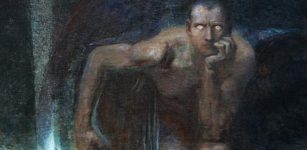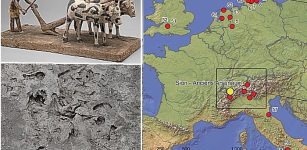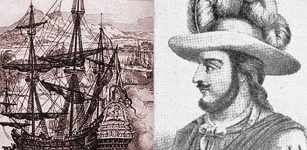Highly Advanced Robots In Ancient China
A. Sutherland - AncientPages.com - In ancient China we come across a number of highly advanced robots that could sing, dance, act like servants and perform many other surprising tasks.
Some of these remarkable robots are even said to have possessed life-like organs such as bones, muscles, joints, skin and hair. It’s a quite remarkable considering it is only recently our modern civilization has started to develop human-like robots.
There is no doubt mechanical engineering in ancient China reached a very high level.
Other technological achievements of the ancients can be ancient machines invented by Hero of Alexandria, or the remarkable Talos robot, but there are many more great examples of ancient robotics discovered in various corners of the world.
History of robots in ancient China can be traced far back in time. Robots existed not only during, but also before the Tang Dynasty (618–907 AD).
An ancient Chinese book, Stories of Government and the People (or Chao Ye Qian Zai), contains many fascinating tales describing ancient mechanical engineering technology.
For example, King Lan Ling, who lived during the Northern Qi Dynasty (550-577 A.D.) invented a robot that could dance and that looked like a man of a non-Chinese ethnic group. When the King wanted to offer a drink to a man, the robot would turn to that man, and bow to the man with the drink in his hand. Nobody knows what secret mechanism was inside the robot.
In the book Robotics in Genitourinary Surgery, authors Ashok Kumar Hemal (Editor), Mani Menon relate how Daifeng Ma, a skilled designer constructed not only mechanical birds that measured the wind’s direction, but also a famous automated device that served as a dresser or the queen.
"Through ingenious levers and switches, when the queen opened the mirror, the doors beneath automatically opened as well. He devised a robotic woman servant for the queen that would bring washing paraphernalia and towels.
Then the towel was removed from the servant’s arm, it automatically triggered the machine to back away into the closet."
Returning back to the Northern Qi Dynasty (550-577 A.D.) we encounter a monk named Ling Zhao who created a pool close to a mountain.
According to author Ming Xin, "after the pool was finished, Emperor Wu Cheng enjoyed a feast next to the pool. Ling built a miniature boat with exquisite details and put it in the water. When the miniature boat flowed before the Emperor, he took a wine cup from it, and the boat would stop automatically.
Then the small wooden man on the boat would clap its hands, and the boat would start to play music. When Emperor Wu Cheng finished drinking and put down the wine cup, the small wooden man would take the cup back to the boat.
If Emperor Wu Cheng did not finish drinking the wine in the cup, the boat would stay there and would not leave."
Another skilled mechanical engineer was Yin Wenliang from Luozhou.
"He created a wooden man and dressed him with an outfit made of colorful worsted silk. At every banquet, the small wooden man would propose a toast to each guest in order. Yin Wenliang also made a wooden woman. She could play the sheng (an ancient Chinese pipe with 13 reeds) and sing, and she did them in perfect rhythm. If a guest did not finish the wine in his cup, the wooden man wouldn't refill the cup.
If a guest did not drink enough wine, the wooden singing girl would play the sheng and sing for him to urge him to drink more.
Nobody could figure out the marvellous secret of these two wooden robots."
The last example we mention, is the best documented of all the automata from Han Zhile, a Japanese ho moved to China between 806 and 820 AD.
According to Hemal and Menon, "he is known to have created mechanical birds, phoenixes, cranes, crows, and magpies. Though made of wood, some of the ornithologic prototypes could be made to pretend to eat, drink, chirp, and warble like real birds. He is reported to have installed mechanical devices inside some of the birds to drive their wings to make them fly. He is reported to have also created a mechanical cat.

Exhibit in the Science Museum in London, England. This conjectural model chariot incorporates a differential gear. Image via wikipedia
One of the most marvelous creatures was an automated bed for the Emperor Xianzong named "a dragon on demand." It was activated by someone applying their weight to the bed thus triggering the release of an intricately carved dragon.
Presented here is just a small sample of robotics that existed in ancient China.
As previously mentioned in our article, the first known cybernetic machine, the south-pointing carriage was invented already 1,700 years ago!
All these remarkable advanced devices force us to re-evaluate our current understanding of mechanical engineering in ancient times.
Written by – A. Sutherland - AncientPages.com Senior Staff Writer
Copyright © AncientPages.com All rights reserved. This material may not be published, broadcast, rewritten or redistributed in whole or part without the express written permission of AncientPages.com
More From Ancient Pages
-
 Who Can Solve The Shackleton Scribble Mystery?
Artifacts | Sep 13, 2017
Who Can Solve The Shackleton Scribble Mystery?
Artifacts | Sep 13, 2017 -
 Did The Great Sphinx Of Giza Have A Twin And Was It Destroyed By A Lightning Strike?
Featured Stories | Dec 23, 2017
Did The Great Sphinx Of Giza Have A Twin And Was It Destroyed By A Lightning Strike?
Featured Stories | Dec 23, 2017 -
 4,000 Years Ago Women Of El Argar Used Their Teeth As Tools
Archaeology | Nov 10, 2020
4,000 Years Ago Women Of El Argar Used Their Teeth As Tools
Archaeology | Nov 10, 2020 -
 Famous Runestone Is Not What We Thought And Re-Writes History Of The Vikings – Scholar Argues
Vikings | Jan 23, 2025
Famous Runestone Is Not What We Thought And Re-Writes History Of The Vikings – Scholar Argues
Vikings | Jan 23, 2025 -
 Ancient City Of Sogmatar And Recent Discovery Of 5,000-Year-Old Children’s Toy
Archaeology | Oct 6, 2017
Ancient City Of Sogmatar And Recent Discovery Of 5,000-Year-Old Children’s Toy
Archaeology | Oct 6, 2017 -
 Mysterious Giant Rock Face Discovered On B.C’s Central Coast – Natural Or Man-Made Structure?
News | Mar 28, 2020
Mysterious Giant Rock Face Discovered On B.C’s Central Coast – Natural Or Man-Made Structure?
News | Mar 28, 2020 -
 Ancient Mysteries Of West Virginia: Did Ancient Celts Visit North America Where They Left An Ogham Inscribed Bone Needle With Christian Symbols?
Artifacts | Mar 1, 2017
Ancient Mysteries Of West Virginia: Did Ancient Celts Visit North America Where They Left An Ogham Inscribed Bone Needle With Christian Symbols?
Artifacts | Mar 1, 2017 -
 10,000-Year-Old Adorned Female Infant Burial Discovered In European Cave
Archaeology | Dec 14, 2021
10,000-Year-Old Adorned Female Infant Burial Discovered In European Cave
Archaeology | Dec 14, 2021 -
 Identity Of Anti-Christ And Number 666 Revealed By Ancient History Professor
Archaeology | Apr 6, 2019
Identity Of Anti-Christ And Number 666 Revealed By Ancient History Professor
Archaeology | Apr 6, 2019 -
 2,000-Year-Old Poorly Preserved Mummies Unearthed Near Saqqara’s Pyramid of Djoser
Archaeology | Jul 3, 2019
2,000-Year-Old Poorly Preserved Mummies Unearthed Near Saqqara’s Pyramid of Djoser
Archaeology | Jul 3, 2019 -
 Exciting Find In The Swiss Alps – First Furrows And Animal Tracks Are Evidence Of Prehistoric Plowing
Archaeology | Apr 3, 2024
Exciting Find In The Swiss Alps – First Furrows And Animal Tracks Are Evidence Of Prehistoric Plowing
Archaeology | Apr 3, 2024 -
 Looted ‘Pietas Domini’ Gothic Altar Dated To 1435 AD Returns From Germany To Poland
Archaeology | Mar 22, 2020
Looted ‘Pietas Domini’ Gothic Altar Dated To 1435 AD Returns From Germany To Poland
Archaeology | Mar 22, 2020 -
 Stone Tools In Lapa do Picareiro Cave Reveal Modern Humans Reached Western Parts Of Europe 5,000 Years Earlier Than Previously Thought
Archaeology | Sep 30, 2020
Stone Tools In Lapa do Picareiro Cave Reveal Modern Humans Reached Western Parts Of Europe 5,000 Years Earlier Than Previously Thought
Archaeology | Sep 30, 2020 -
 Neanderthals And Homo Sapiens Invented Different Fire Techniques – Evolution Of Human Cognition
Archaeology | Jun 1, 2023
Neanderthals And Homo Sapiens Invented Different Fire Techniques – Evolution Of Human Cognition
Archaeology | Jun 1, 2023 -
 Study Traces DNA Of Inca Emperors To Their Modern-Day Descendants
Archaeology | May 29, 2018
Study Traces DNA Of Inca Emperors To Their Modern-Day Descendants
Archaeology | May 29, 2018 -
 3,500-Year-Old Egyptian Tomb Of Guardian Of Pharaoh’s Secret Archive Discovered In Saqqara
Archaeology | May 7, 2022
3,500-Year-Old Egyptian Tomb Of Guardian Of Pharaoh’s Secret Archive Discovered In Saqqara
Archaeology | May 7, 2022 -
 Rare Ancient Leopard Painting Discovered On Sarcophagus In Aswan, Egypt
Archaeology | Feb 25, 2020
Rare Ancient Leopard Painting Discovered On Sarcophagus In Aswan, Egypt
Archaeology | Feb 25, 2020 -
 Delphic Mysteries – Extraordinary Encounter At An Ancient Temple – Part 2
Ancient Mysteries | Apr 3, 2023
Delphic Mysteries – Extraordinary Encounter At An Ancient Temple – Part 2
Ancient Mysteries | Apr 3, 2023 -
 Gil Pérez: Unexplained Ancient Teleportation Of A Spanish Soldier
Featured Stories | Oct 15, 2018
Gil Pérez: Unexplained Ancient Teleportation Of A Spanish Soldier
Featured Stories | Oct 15, 2018 -
 Vikings’ Hideouts, Harbours And Homes: How Norse Warriors Owed Their Success To Their Encampments
Featured Stories | Feb 17, 2023
Vikings’ Hideouts, Harbours And Homes: How Norse Warriors Owed Their Success To Their Encampments
Featured Stories | Feb 17, 2023



